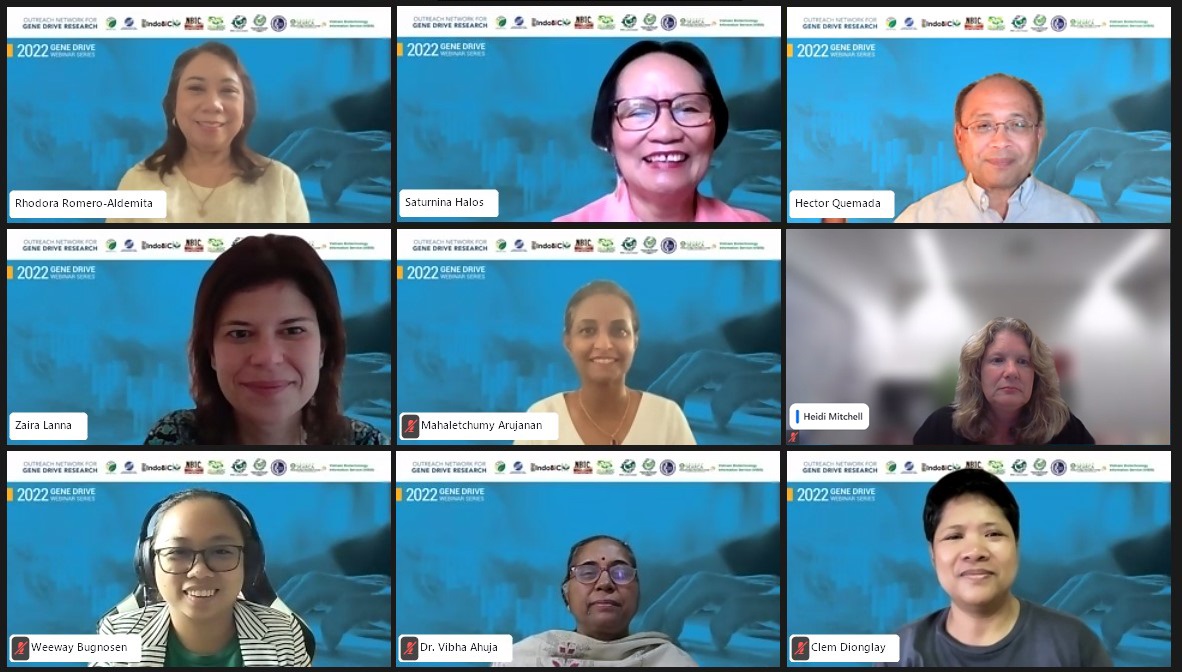
Existing Regulatory Frameworks Can Help Guide Gene Drive Risk Assessment -Experts
June 29, 2022| |
On June 16, 2022, ISAAA Inc., the Outreach Network for Gene Drive Research, and the ISAAA Biotechnology Information Centers Network conducted the webinar Key Considerations for Risk Assessment of Gene Drive Technologies via Zoom. The webinar speakers were unanimous that learning from the practice of existing regulatory frameworks and guidelines for genetic modification is important to successfully conduct risk assessment for gene drives.
The webinar, which is the second part of the 2022 Gene Drive Webinar Series, began with the opening remarks from Dr. Rhodora Romero-Aldemita, ISAAA Inc. Executive Director. She provided a brief overview of the activity by highlighting the three key topics to be addressed by the resource speakers through their presentations. This was followed by the introduction of the speakers by the moderator, Dr. Saturnina C. Halos, President and Chair of the Board of Directors of the Biotechnology Coalition of the Philippines.
Dr. Heidi Mitchell, Director of the Contained Dealings Evaluation Section of the Office of the Gene Technology Regulator (OGTR) of the Australian Department of Health, talked about the Australian gene technology legislation and how risk assessment is done for GMOs. She related this to how risk assessment for gene drives could be carried out, then concluded by giving updates about the ongoing discussions related to gene drives in international conventions.
Dr. Vibha Ahuja, Chief General Manager of Biotech Consortium India Ltd., explained the four key requirements for regulating gene drives. She highlighted the importance of capacity building for the effective implementation of biosafety frameworks and to facilitate science-based risk assessments.
Dr. Hector Quemada of Western Michigan University presented a range of applications of gene drive research that are currently being explored to address issues in both public health and biodiversity conservation. He said that gene drive researchers must learn from the experiences of other risk assessment disciplines, as well as from risk assessment approaches previously used for genetically modified organisms and other ecological risk assessments.
The webinar ended with Dr. Halos' summary of the webinar key points and the closing remarks from Dr. Mahaletchumy Arujanan, ISAAA-BioTrust Global Coordinator and Executive Director.
A more comprehensive summary of the presentations is published in ISAAA Inc.'s Science Speaks blog. The recording of the webinar and presentation slides are available in ISAAA Webinars.
| |
You might also like:
- Guidelines Expanded for Arthropod Gene Drive Research
- Lessons Learned from Target Malaria to Help Guide Future Gene Drive Strategies
- Gene Drive Regulations to Evolve as the Technology Advances -Experts
Biotech Updates is a weekly newsletter of ISAAA, a not-for-profit organization. It is distributed for free to over 22,000 subscribers worldwide to inform them about the key developments in biosciences, especially in biotechnology. Your support will help us in our mission to feed the world with knowledge. You can help by donating as little as $10.
-
See more articles:
-
Gene Drive Supplement (June 29, 2022)
- Existing Regulatory Frameworks Can Help Guide Gene Drive Risk Assessment -Experts
- First Feasible Gene Drive System for Invasive Rodent Population Control
- Modelling the Potential Spread of Gene Drive Mosquitoes
- Recommendations for Environmental Risk Assessment of Gene Drive for Malaria Vector Control
- Researching Gene Drive Mosquitoes to Help Malaria Control
- Fighting Malaria with Gene Drive and Community Involvement
-
Read the latest: - Biotech Updates (December 3, 2025)
- Gene Editing Supplement (November 26, 2025)
- Gene Drive Supplement (February 22, 2023)
-
Subscribe to BU: - Share
- Tweet

